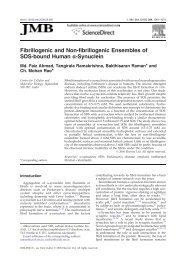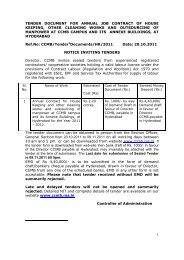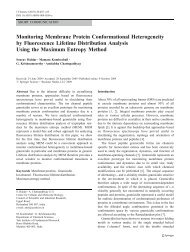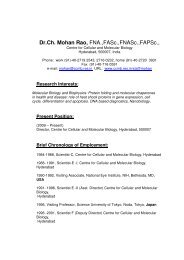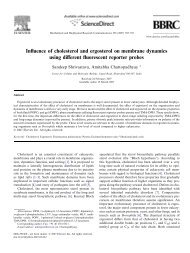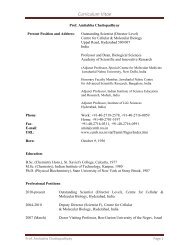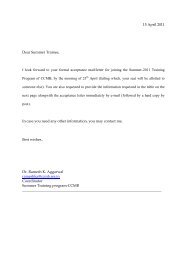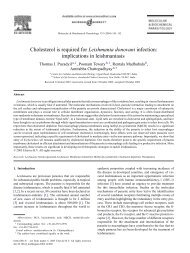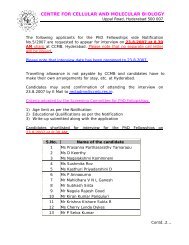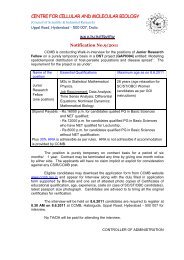Thraustochytrium gaertnerium sp. nov.: a New Thraustochytrid - CCMB
Thraustochytrium gaertnerium sp. nov.: a New Thraustochytrid - CCMB
Thraustochytrium gaertnerium sp. nov.: a New Thraustochytrid - CCMB
Create successful ePaper yourself
Turn your PDF publications into a flip-book with our unique Google optimized e-Paper software.
ARTICLE IN PRESSProtist, Vol. 156, 303—315, August 2005http://www.elsevier.de/protisPublished online date 3 August 2005ORIGINAL PAPER<strong>Thraustochytrium</strong> <strong>gaertnerium</strong> <strong>sp</strong>. <strong>nov</strong>.: a <strong>New</strong><strong>Thraustochytrid</strong> Stramenopilan Protist fromMangroves of Goa, IndiaLucia Bongiorni a,1 , Ruchi Jain a , Seshagiri Raghukumar a,2,3 , and Ramesh Kumar Aggarwal ba National Institute of Oceanography, Dona Paula, Goa — 403 004, Indiab Centre for Cellular and Molecular Biology, Uppal Road, Hyderabad — 500 007, IndiaSubmitted December 22, 2004; Accepted May 19, 2005Monitoring Editor: Míchael Melkonian<strong>Thraustochytrid</strong>s are ubiquitous, chemo-organotrophic, marine stramenipilan protists belonging tothe class Labyrinthulomycetes. Their taxonomy is largely based on life cycle development stages. Wedescribe here a new <strong>sp</strong>ecies of thraustochytrid isolated from mangroves of Goa, India. The organismis characterized by large zoo<strong>sp</strong>orangia with two distinct development cycles. In one, typical thalli withectoplasmic net elements mature into zoo<strong>sp</strong>orangia that divide to form heterokont biflagellatezoo<strong>sp</strong>ores, leaving behind a proliferation body. In the second type, the thalli develop into amoeboidcells, reminiscent of the genus Ulkenia Gaertner. Unlike Ulkenia, however, the ‘amoebae’ do notimmediately produce zoo<strong>sp</strong>ores, but round up prior to division into zoo<strong>sp</strong>ores. The two types ofdevelopment occur simultaneously in single cell-derived in- vitro cultures. Molecular characterizationof the new isolate involving 18S rRNA gene typing and comparative phylogenetic analysis furtherestablish it to be a new and distinct thraustochytrid <strong>sp</strong>ecies with Schizochytrium aggregatumGoldstein and Belsky and <strong>Thraustochytrium</strong> kinnei Gaertner as the closest forms. We have named thisnew <strong>sp</strong>ecies as <strong>Thraustochytrium</strong> <strong>gaertnerium</strong>, deriving its <strong>sp</strong>ecies name in honour of Dr AlwinGaertner, a pioneer in the studies of taxonomy and ecology of thraustochytrids.& 2005 Elsevier GmbH. All rights reserved.Key Words: <strong>Thraustochytrium</strong> <strong>gaertnerium</strong> <strong>sp</strong>. <strong>nov</strong>.; thraustochytrids; Straminipila; mangroves; India.Introduction<strong>Thraustochytrid</strong>s are a wide<strong>sp</strong>read group ofmarine fungi, belonging to the Kingdom Chromista(Cavalier-Smith 1993; Cavalier-Smith et al. 1994)1 Department of Marine Science, Polytechnic University ofMarche, Via Brecce Bianache, 60131, Ancona, Italy2 Corre<strong>sp</strong>onding author;e-mail raghu@darya.nio.org (S. Raghukumar)3 Present address: 313, Vainguinnim Valley, Dona Paula, Goa403 004, Indiaor Straminipila (Dick 2001; Raghukumar 2002).Typically chemoorganotrophic and morphologicallyresembling chytridiaceous and oomycetanfungi, they were originally placed among thephycomycetous fungi (Sparrow 1960) or the KingdomFungi (Eumycota of Ainsworth et al. 1973),prior to their transfer to the Straminipila. <strong>Thraustochytrid</strong>sdiffer from members of the KingdomFungi in several ways. Their cell walls are multilamellate,made up of dictyosome-derived circular& 2005 Elsevier GmbH. All rights reserved.doi:10.1016/j.protis.2005.05.001
ARTICLE IN PRESSA new <strong>Thraustochytrid</strong> from Mangroves 305
306 L. Bongiorni et al.ARTICLE IN PRESS
ARTICLE IN PRESSA new <strong>Thraustochytrid</strong> from Mangroves 307behind. Mature thalli in the second type becomingamoeboid. Amoebae 25—40 mm in length and12.5—27.5 mm wide, with a hyaline, sheath-likeectoplasm and a granular endoplasm, exhibitingvery slow movements. Amoebae rounding up toform zoo<strong>sp</strong>orangia as above. No proliferationbody remains. Zoo<strong>sp</strong>ores measuring 5.5—7.3 mmin length and 3—4.5 mm wide.Life cycle and TaxonomyYoung vegetative cells resulting from freshlyencysted zoo<strong>sp</strong>ores measured around 4—5 mmin diameter (Fig. 1). In pine pollen cultures, suchcells developed into mature thalli in about24—25 h. During the course of development (after18 h), young thalli of 10—15 mm diameter werefilled with prominent droplets (Fig. 2). Two differenttypes of development were observed. In Type I,the young thallus developed directly into a maturethallus. At the onset of maturity, prior to zoo<strong>sp</strong>oreformation, the contents of the mature thallus, thezoo<strong>sp</strong>orangium, became granular in appearance(Fig. 3). The zoo<strong>sp</strong>orangium was characterized bya thin cell wall and measured 15—30 mm indiameter. The first sign of zoo<strong>sp</strong>ore formationwas the appearance of an undulate outer marginof the zoo<strong>sp</strong>orangial contents (Fig. 4). Cleavage ofzoo<strong>sp</strong>ores then took place rapidly and outlines ofthe zoo<strong>sp</strong>ores became visible (Figs 5, 6). Theproliferation body was clearly visible at this stage(Fig. 7). Prior to their liberation, the zoo<strong>sp</strong>oresshowed rapid movements inside the zoo<strong>sp</strong>orangiumfor a very short period. Zoo<strong>sp</strong>ores wereinitially released through a tear in the cell wall (Fig.8). As zoo<strong>sp</strong>ore release progressed, most of thecell wall disintegrated totally (Figs 9, 10). A largeproliferation body, 5—10 mm in diameter was left,following the release of the zoo<strong>sp</strong>ores (Fig. 10).The zoo<strong>sp</strong>orangia produced 10—75 zoo<strong>sp</strong>ores.Zoo<strong>sp</strong>ores were bean-shaped and possessed twoflagella (Fig. 11). The flagella were apicallyattached, the long anterior and the shorter posteriorlocated one below the other. The zoo<strong>sp</strong>oresmeasured 3—4.5 5.5—7 mm in size, with alength-to-width ratio of 1.4:1 to 2:1. The duration,starting from the time of zoo<strong>sp</strong>ore initiation till therelease of all the zoo<strong>sp</strong>ores was approximately60 min. Amoebae and zoo<strong>sp</strong>ores were alsoobserved in the agar medium. Prominent,branched ectoplasmic net elements were producedboth in pine pollen culture and MV agarmedium (Fig. 12). Colonies of the thraustochytridin MV agar were circular to subcircular andcontained large, globose, hyaline cells (Fig. 13).In addition to the above mode of zoo<strong>sp</strong>oreformation, an amoeboid mode (Type II) was seensimultaneously in cultures. Some of the maturethalli, instead of developing into zoo<strong>sp</strong>orangia,began to assume an amoeboid shape (Figs 13,14). This transformation into amoebae was rapidand was complete in less than 1 minute. Such‘amoebae’ ranged from 25 to 40 mm in length and12.5—27.5 mm in width. They were characterizedby a very prominent, hyaline and sheath-likeectoplasm, while the rest of the cell was denselygranular (Fig. 15—17). The amoebae were capableof rapid transformation of shape and moved veryslowly (Figs 15—18). The amoeboid stage lastedabout 15 min. We did not detect any bacterivoryby such amoebae in cultures contaminated withbacteria. Subsequently, the amoebae rapidlyrounded up into cells that had the same dimensionsas normal zoo<strong>sp</strong>orangia (Figs 18—20).Rounded up protoplasts were smaller than theamoebae, presumably because the latter wereflat. At this stage the presence of the cell wall thathad earlier surrounded the cell could be discerned(Figs 21—24). These cells, the zoo<strong>sp</strong>orangia of‘Type II’ divided into zoo<strong>sp</strong>ores in a manner similarto those of ‘Type I’ (Figs 21—25). No proliferationbodies were detected in the Type II zoo<strong>sp</strong>orangiaat the end of zoo<strong>sp</strong>ore division (Figs 26, 27). Thenumber of zoo<strong>sp</strong>ores produced by these wassimilar to those of Type I and no differences werenoticed in the zoo<strong>sp</strong>ore shape. Numerous amoeboidcells were seen at the bottom of the Petriplate in seawater/pine pollen cultures of about4—7 days. During the early stages of establishingaxenic cultures, numerous cigar-shaped, limaxamoebae were regularly observed in the culturesThese were not subsequently noticed in seawater/Figures 14—27. <strong>Thraustochytrium</strong> <strong>gaertnerium</strong> <strong>sp</strong>. <strong>nov</strong>. Type II Developmental stages. 14. Maturezoo<strong>sp</strong>orangium. 15. Transformation of mature cell into an amoeboid cell. 16—18. Rapid changes in shapeof the amoeboid cell. Arrow in Figs 17 and 18 indicate the ectoplasm. 19—20. Rounding up of the amoeboidcell. 21. Initiation of zoo<strong>sp</strong>ore cleavage of the rounded up amoeboid cell. 22—24. Mature zoo<strong>sp</strong>orangium.Note the presence of a loose cell wall. 25—27. Zoo<strong>sp</strong>ore release. Figs 16—27 are from the same cell. Arrowsin Figs 22—25 indicate the remnants of a cell wall. Bar in Figure 14 represents 20 mm and is common to Figs14—27.
ARTICLE IN PRESS308 L. Bongiorni et al.pine pollen cultures. However, in one instance,when a culture grown on MV broth was transferredto the continuous flow chamber, as mentionedunder ‘Methods’, numerous normal, globose cellstransformed into such limaciform amoebae within3 h. Such amoebae measured 22—26 mm in lengthand 3.6—5.5 mm in width and also rounded uplater to form Type II zoo<strong>sp</strong>orangia. Motile zoo<strong>sp</strong>oreswere observed in cultures up to 1 monthold. Limaciform amoebae are not unusual amongthraustochytrids. Honda et al. (1998) have describedvery similar amoebae in the life cycle ofSchizochytrium limacinum. Such amoebae alsoform part of the life cycle of Ulkenia amoeboidea(Raghukumar 1980).The behaviour of the thraustochytrid in a rich,organic medium, the MV broth, did not differ fromthat in seawater/pine pollen cultures. Type Izoo<strong>sp</strong>orangia, amoebae and Type II zoo<strong>sp</strong>orangiawere produced also in MV broth. However, thezoo<strong>sp</strong>orangia were much larger and measured17.5—50 mm in diameter. Zoo<strong>sp</strong>ore numbersreached values of 20—80 per <strong>sp</strong>orangium.Phylogenetic analyses based on the 18S rRNAgene sequence variation, irre<strong>sp</strong>ective of theclustering algorithm (NJ and ML), robustly establishthe protist <strong>sp</strong>ecies analysed and described inthis study, to be a new member of the Labyrinthulomycetes,genetically closest but significantlydistinct from all other referencethraustochytrids compared in the analysis (Figs28, 29; Table 2). The overall topologies of differentphenetic trees obtained in the study were similarto each other except for minor differences in thebranch lengths. Further, the phylogenetic analysisrevealed three broad lineages of the comparedtaxa, as has been observed earlier by others,namely the labyrinthulids, aplanochytrids and thethraustochytrids (Honda et al. 1998; Leander andPorter 2001). The phylogenetic tree shows thatwithin the lineage comprising the thraustochytrids,<strong>sp</strong>ecies of the 3 major genera, <strong>Thraustochytrium</strong>,Ulkenia and Schizochytrium are inter<strong>sp</strong>ersedamong each other. A similar observation has beenmade by Honda et al. (1998). This suggests thatthe major morphological characters on which thethraustochytrid taxonomy is based are homoplasious.In other words, binary division, the amoeboidstage, or division within zoo<strong>sp</strong>orangia mighthave evolved independently several times withinthe thraustochytrids. This makes the classificationof thraustochytrid <strong>sp</strong>ecies difficult, when basedsolely on morphological characters. In the presentcase, the <strong>sp</strong>ecies morphologically resembles thegenus <strong>Thraustochytrium</strong> Sparrow in its Type Idevelopment and Ulkenia Gaertner in its Type IIdevelopment. In <strong>Thraustochytrium</strong>, the contents ofthe zoo<strong>sp</strong>orangium divide into zoo<strong>sp</strong>ores whilestill enclosed within the rigid cell wall. Zoo<strong>sp</strong>oresare liberated by a tear in the wall or its partial ortotal disintegration. Gaertner (1977) erected thegenus Ulkenia to include <strong>sp</strong>ecies in which thecytoplasmic contents are released as a nakedprotoplast either because of a total disappearanceof the cell wall or through the escape of theprotoplast through an opening in the cell wall. Theprotoplast then undergoes amoeboid movements,prior to division into zoo<strong>sp</strong>ores. The amoeboidmovement of the protoplast in the Type II developmentof the present <strong>sp</strong>ecies resembles that inUlkenia. However, the protoplast subsequentlyrounded up prior to division into zoo<strong>sp</strong>ores anddid not undergo divisions while the amoeboidstage persisted, as in the genus Ulkenia (Gaertner1977). Besides, the cell wall of the zoo<strong>sp</strong>orangiumappeared to have persisted throughout, becomingevident when the ‘amoebae’ rounded up (Figs21—24). Molecular phylogenetic analyses provideda clearer picture of the taxonomic positionof this <strong>sp</strong>ecies. In all the phenetic trees <strong>Thraustochytrium</strong><strong>gaertnerium</strong> appears as a distinct newmember of the thraustochytrid group with T. kinneias the closest known <strong>sp</strong>ecies of the Genus<strong>Thraustochytrium</strong>. However, the sister taxon (andthus the closest relative) to T. <strong>gaertnerium</strong> is agroup of four taxa comprising S. aggregatum and3 other thraustochytrids whose accession nos. aregiven in Table 2. The present <strong>sp</strong>ecies is beingdescribed as a new <strong>sp</strong>ecies of Thraustochytium,based both on the 18S rRNA gene sequences andthe Type I development.The genus <strong>Thraustochytrium</strong> Sparrow is characterizedby monocentric, eucarpic, epi- andendobiontic thalli that produce ectoplasmic netelements. The entire contents or part of thecontents of the mature thalli, the zoo<strong>sp</strong>orangiadivide into zoo<strong>sp</strong>ores. Zoo<strong>sp</strong>ores are characteristicallyheterokont, with a longer apical, tinsel andshorter, posterior whiplash flagellum. One or moreproliferation bodies may be produced. Zoo<strong>sp</strong>oresare liberated by a tear in the wall or a partial ortotal disintegration of the cell wall of the zoo<strong>sp</strong>orangia.The proliferation bodies persist after zoo<strong>sp</strong>oresare liberated. Morphologically, the present<strong>sp</strong>ecies resembles <strong>Thraustochytrium</strong> aureumGoldstein (Goldstein 1963a), T. motivum Goldstein(Goldstein 1963b), T. kinnei Gaertner (Gaertner1967) and T. benthicola Raghukumar (Raghukumar1988) in the production of a single proliferationbody. The proliferation body in T. motivum and T.
ARTICLE IN PRESSA new <strong>Thraustochytrid</strong> from Mangroves 309Figure 28. Phylogenetic analysis of the thraustochytrids, aplanochytrids and labytrinthulids bases on themultiple alignments of 18S rDNA sequences. The Neighbour joining tree is constructed using Kimura 2-parameter. The numbers at each internal branching shows bootstrap values only for the nodes supported bymore than 50%. (500 replicates). The numbers on the branches are the branch lengths. Bar represents 0.065mutations per site.kinnei is distinctly large and formed much beforethe zoo<strong>sp</strong>ores are cleaved. The <strong>sp</strong>orangia arepyriform to ovate as compared to the globose tosubglobose zoo<strong>sp</strong>orangia of T. <strong>gaertnerium</strong> andfewer zoo<strong>sp</strong>ores are produced. <strong>Thraustochytrium</strong>benthicola produces irregularly shaped zoo<strong>sp</strong>or-
ARTICLE IN PRESS310 L. Bongiorni et al.Figure 29. Phylogenetic analysis of the thraustochytrids, aplanochytrids and labytrinthulids bases on themultiple alignments of 18S rDNA sequences. The phylogram is the best maximum likelihood tree ðlnðLÞ ¼10234:017Þ and distance is calculated using gamma corrected Kimura 2-parameter. The numbers at eachinternal branching shows bootstrap values only for the nodes supported by more than 50%. (500 replicates).The numbers on the branches are the branch lengths. Bar represents 0.089 mutations per site.
ARTICLE IN PRESSA new <strong>Thraustochytrid</strong> from Mangroves 311angia. T. aureum is distinct from the present<strong>sp</strong>ecies in that it produces smaller zoo<strong>sp</strong>orangia(8—17 mm) and contains fewer zoo<strong>sp</strong>ores (lessthan 50). None of the above <strong>sp</strong>ecies has the<strong>sp</strong>ecial Type II development found in T. <strong>gaertnerium</strong>.Schizochytrium aggregatum which appears ina sister clade to T. <strong>gaertnerium</strong> is morphologicallya distinct genus, characterized by repeated binarydivisions of the vegetative cells. The following keydistinguishes T. <strong>gaertnerium</strong> from other <strong>sp</strong>ecies of<strong>Thraustochytrium</strong> that produce one or moreproliferation bodies.seawater were poured in sterile 5 cm Petri dishes.A small amount of pine pollen, sterilized in an ovenat 100 1C for 48 h was added as ‘bait’. The plateswere incubated at room temperature (approximately28—30 1C) and were examined for growthof thraustochytrids after 3—7 days. The organismwas isolated in axenic cultures by subculturing inseawater/pine pollen as above, but with anaddition of 0.075% streptomycin and 0.036%penicillin. Absence of bacteria in this culture wasconfirmed microscopically and also by streakingthe culture on Modified Vishniac’s (MV) agar plates1. Single proliferation body produced.................................................................................................... 21. More than one proliferation body produced...................................................................................... 82. Proliferation body delineated prior to zoo<strong>sp</strong>ore formation; prominent............................................. 32. Proliferation body delineated during zoo<strong>sp</strong>ore formation; not prominent......................................... 63. Zoo<strong>sp</strong>ores nonmotile at the time of discharge, lacking flagella; developing flagella subsequently.................................................................................................................... <strong>Thraustochytrium</strong> proliferum3. Zoo<strong>sp</strong>ores motile even at the time of discharge, with fully formed flagella...................................... 44. Cell wall mostly persistent, or persistent as a small collar following zoo<strong>sp</strong>ore discharge.................54. Cell wall totally disintegrating following zoo<strong>sp</strong>ore discharge............................................................................................................................................................................ <strong>Thraustochytrium</strong> antarcticum5. Zoo<strong>sp</strong>orangia globose, subglobose or obpyriform, most of the cell wall persistent after zoo<strong>sp</strong>oreliberation.................................................................................................... <strong>Thraustochytrium</strong> motivum5. Zoo<strong>sp</strong>orangia obpyriform, most of the cell wall disintegrates during zoo<strong>sp</strong>ore liberation, leaving justa collar around the zoo<strong>sp</strong>orangium............................................................... <strong>Thraustochytrium</strong> kinnei6. Zoo<strong>sp</strong>orangia smaller than 20 mm ; not more than 50 zoo<strong>sp</strong>ores per zoo<strong>sp</strong>orangium; no amoeboidstages produced during life cycle..................................................................................................... 76. Zoo<strong>sp</strong>orangia often up to 30 mm diam; up to 75 zoo<strong>sp</strong>ores produced; Amoeboid stages presentduring life cycle................................................................. <strong>Thraustochytrium</strong> <strong>gaertnerium</strong> <strong>sp</strong>. <strong>nov</strong>.7. Zoo<strong>sp</strong>orangia irregular in shape; zoo<strong>sp</strong>ores ovoid; flagella apical and subapical............................................................................................................................................. <strong>Thraustochytrium</strong> benthicola7. Zoo<strong>sp</strong>orangia up to 17 mm in diam; less than 50 zoo<strong>sp</strong>ores produced; flagella lateral.......................................................................................................................................... <strong>Thraustochytrium</strong> aureum8. Number of proliferation bodies not more than 4, zoo<strong>sp</strong>ores motile at discharge..................................................................................................................................... <strong>Thraustochytrium</strong> multirudimentale8. Number of proliferation bodies more than 4....................................................................................109. Number of proliferation bodies 5—50; zoo<strong>sp</strong>ores not motile at the time of discharge.............................................................................................................................................. <strong>Thraustochytrium</strong> rossii9. Number of proliferation bodies 3—10; zoo<strong>sp</strong>ores motile at discharge........................................................................................................................................................... <strong>Thraustochytrium</strong> kerguelensisMethodsThe protist analysed and described in this studywas isolated during April 1999 from waterscollected from Chorao mangroves in Goa (Lat:15127’N; Long: 73148’E). Samples were collectedusing sterile glass vials and brought to thelaboratory within 1 h for isolation using the pinepollen baiting method (Gaertner 1968; Porter1990). About 3 ml water sample and 2 ml of sterile(Perkins 1972). Bacteria-free colonies were subculturedin seawater/pine pollen cultures. A singlepine pollen grain with a thraustochytrid cellattached to it was picked up using a fine glassloop. Several single cell cultures were establishedfrom this initial culture. The cultures were maintainedon MV agar butts as stab cultures. The typeculture, on which the description and analyses arebased is deposited at the American Type CultureCollection (ATCC), USA under the accession
ARTICLE IN PRESS312 L. Bongiorni et al.Table 1. Primers used in this study.Primer name Primer sequence Direction Reference18S001 5 0 -AACCTGGTTGATCCTGCCAGTA-3 0 Forward Honda et al. 199918S13 5 0 -CCTTGTTACGACTTCACCTTCCTCT-3 0 Reverse Honda et al. 1999NS3 5 0 -GCAAGTCTGGTGCCAGCAGCC-3 0 Reverse White et al. 1990NS4 5 0 -CTTCCGTCAATTCCTTTAAG-3 0 Forward White et al. 1990M13F 5 0 -GTAAAACGACGGCCAGT-3 0 ForwardM13R 5 0 -AACAGCTATGACCATG-3 0 Reversenumber ATCC PRA-148. A subculture of this isalso deposited in the culture collection of theNational Institute of Oceanography, Goa, underAccession number NIOS-6.Development of the thraustochytrid was studiedusing sea water/pine pollen cultures or 2 days oldcultures in MV broth. A modified design of acontinuous flow micro-chamber as described byRaghukumar (1987) was used for observing thelife cycle under a microscope for up to 3 days. Allobservations were made using an Olympus BX 60microscope and photomicrography using OlympusPM-20 unit.The 18S rRNA gene-based phylogenetic analysiswas undertaken to ascertain the taxonomicaffiliation of the thraustochytrid. Most of themethods used for the purpose were as detailedby Sambrook et al. (1989), except for the indicatedmodifications. Total genomic DNA was isolatedaccording to the procedure of Sheriff et al. (1994).The concentration and purity of the DNA waschecked on 0.8% agarose gel in 1% TAE buffer.The small subunit rRNA gene was amplified bypolymerase chain reaction (PCR) on the DNAthermocycler PTC 200 (MJ Research), using the18S rDNA <strong>sp</strong>ecific terminal primers 18S001 and18S13 (Table 1). The primers corre<strong>sp</strong>onded to thenucleotides 1—22 and 1,733—1,757 of theOchromonas danica 18S rRNA gene (accessionnumber: M32704, J02950) (Honda et al. 1999).Approximately 25 ng of genomic DNA was taken in25 ml reaction volume containing 1 PCR buffer,200 mM each of dATP, dCTP, dGTP and dTTP, 5pMoles of each primer, 1.5 mM MgCl 2 , and 1.0 UampliTaq Gold DNA polymerase (Applied Biosystems).Amplification conditions comprised: aninitial denaturation step of 10 min at 94 1C followedby 35 cycles of I min denaturation at 94 1C, 1 minof annealing at 55 1C and 2 min of extension stepat 72 1C and in the end a final extension step of10 min at 72 1C. The PCR products were checkedon 1.5% agarose gel in 1% TAE buffer beforefurther characterization by cloning and sequencing.The PCR products were ligated into pCR s 2.1vector using the TA cloning kit (Invitrogen) accordingto the instructions of the manufacturer. Theconstructs were transformed into Escherichia coliDH5a competent cells by heat shock method.Recombinant plasmids were isolated by alkalinelysis method and inserts were amplified using M13universal primers (Table 1). Amplified inserts werethen sequenced for both the strands on anautomated DNA sequencer ABI-Prism3700 usingthe fluorescence-based detection approach anddideoxy-termination sequencing chemistry as perthe manufacturer’s details (Applied Biosystems).For sequencing, two additional internal primers(Table 1) were used in conjunction with the M13universal primers that were originally used toamplify the cloned inserts.The 18S rRNA gene sequences were edited andassembled using Auto-assembler program (AppliedBiosystems) and deposited in the NCBInucleotide sequence databank (GenBank AccessionNo. AY705753). The final sequences wereused to identify and retrieve 36 related homologoussequences of reference organisms(Table 2) available in the GenBank database(National Center for Biotechnology Information,USA: NCBI Home page http://www.ncbi.nlm.nih.-gov), using the BLASTn program (Altschul et al.1990). The 18S rDNA sequences obtained for theorganism were aligned with corre<strong>sp</strong>onding sequencesbelonging to the 34 reference Labyrinthulomycetes(Table 2) using the programsClustal-X (http://www.igbmc.u-strasbg.fr/BioInfo/)(Higgins and Sharp 1989) and GenDoc (http://www.psc.edu/biomed/genedoc) (Nicholas et al.1997) and also checked manually for large gaps.The aligned sequences were flushed at the endsto avoid missing information for any comparedreference entries. This resulted in a final alignmentof 1600 bp, which was used for further compar-
ARTICLE IN PRESSA new <strong>Thraustochytrid</strong> from Mangroves 313Table 2. List of 18S rRNA gene sequences of relatedLabyrinthulomycota <strong>sp</strong>ecies used as reference taxain this study for ascertaining the generic affiliation ofthe new isolate.OrganismGenBankaccessionnumberOxytricha granuliferaX53486Prorocentrum micansM14649Aplanochytrium kerguelense AB 022103Japanochytrium Sp.AB022104Labyrinthuloides haliotidisU21338Labyrinthula Sp.AB022105Schizochytrium aggregatum AB022106Schizochytrium limaciniumAB022107Schizochytrium minutumAB022108<strong>Thraustochytrium</strong> aggregatum AB022109<strong>Thraustochytrium</strong> aureumAB022110<strong>Thraustochytrium</strong> kinneiL34668<strong>Thraustochytrium</strong> multirudimentale AB022111<strong>Thraustochytrium</strong> striatumAB022112<strong>Thraustochytrium</strong> pachydermum AB022113Ulkenia profundaL34054Ulkenia profunda (#29)AB022114Ulkenia radiataAB022115Ulkenia visurgensisAB022116Thraustochytriidae <strong>sp</strong>. N4-103 AB073309Thraustochytriidae <strong>sp</strong>. N1-27 AB073308Thraustochytriidae <strong>sp</strong>. H6-16 AB073306Thraustochytriidae <strong>sp</strong>. H1-14 AB073305Thraustochytriidae <strong>sp</strong>. F3-1AB073304<strong>Thraustochytrium</strong> <strong>sp</strong>. CHN-1 AB126669Aplanochytrium stocchinoiAJ519935Schizochytrium <strong>sp</strong>. KH105AB052555<strong>Thraustochytrium</strong> <strong>sp</strong>. KK17-3 AB052556Labyrinthulid quahog parasite QPX AF261664Labyrinthulid quahog parasite QPX AF155209Aplanochytrium <strong>sp</strong>. SC1-1AF348520Aplanochytrium <strong>sp</strong>. PR1-1AF348516Aplanochytrium <strong>sp</strong>. PR12-3AF348517Aplanochytrium <strong>sp</strong>. PR15-1AF348518Labyrinthula <strong>sp</strong>.AF348522Thraustochytriidae <strong>sp</strong>. M4-103 AB073307isons. The aligned sequences were then used toderive corrected Kimura two-parameter distance(Kimura 1980) estimates and infer phylogeneticrelationships using both distance based as well asdirect character-state-based methods, namely,neighbour-joining (Saitou et al. 1987) and maximumlikelihood, with analytical routines availablein the software packages PHYLIP 3.5c (Felsenstein1993) (http://evolution.genetics.washington.edu/phylip.html) and Phylo_win (Galtier et al.1996). In phylogenetic analysis, the two alveolates,Prorocentrum micans (Dinoflagellata) andOxytricha granulifera (Ciliphora) were selected asoutgroups to root the phenetic trees as they oftenform sister groups with the straminopiles in the18S rDNA eukaryotic tree. The robustness of thephenetic clustering was ascertained by 500 bootstrapresamplings (Felsenstein 1985).AcknowledgementsOne of us (L.B.) is grateful to the Indian Council ofCultural Relations, <strong>New</strong> Delhi for the award of aPost-doctoral fellowship under the Indo-ItalianCultural Exchange Programme, during the tenureof which this work was carried out. We are alsothankful to the Council of Scientific and IndustrialResearch, <strong>New</strong> Delhi and the Directors of NIO and<strong>CCMB</strong> for support. This is NIO contribution no.4003ReferencesAinsworth GC, Sparrow FK Jr., Sussman AS eds(1973) The Fungi. An Advanced Treatise, Vol. IV B.Academic Press, <strong>New</strong> YorkAltschul SF, Gish W, Miller W, Myers EW, LipmanDJ (1990) Basic local alignment search tool. J MolBiol 215: 403—410Cavalier-Smith T (1993) Kingdom Protozoa and its18 phyla. Microbiol Rev 57: 953—994Cavalier-Smith T, Allsop M, Chao EE (1994)<strong>Thraustochytrid</strong>s are chromists not fungi: signaturesequences of Heterokonta. Philos Trans R Soc LondB 346: 387—397Chamberlain AHL (1980) Cytochemical and ultrastructuralstudies on the cell walls of <strong>Thraustochytrium</strong><strong>sp</strong>p Bot Mar 23: 669—677Chamberlain AHL, Moss ST (1988) The thraustochytrids:a protist group with mixed affinities.Biosystems (Amsterdam) 21: 341—349Darley WM, Porter D, Fuller M (1973) Cell wallcomposition and synthesis via Golgi-directed scaleformation in the marine eucaryote, Schizochytriumaggregatum, with a note on <strong>Thraustochytrium</strong> <strong>sp</strong>.Arch Mikrobiol 90: 89—106Dick MW (2001) Straminipilous Fungi. Kluwer AcademicPublishers, The Netherlands
ARTICLE IN PRESS314 L. Bongiorni et al.Felsenstein J (1985) Confidence limits on phylogenies:an approach using the bootstrap. Evolution 39:783—791Felsenstein J (1993) Documentation of PHYLIP(Phylogeny Inference Package) version 3.5c. Universityof Washington, Seattle, USAGaertner A (1967) Ökologische Untersuchungen aneinem marinen Pilz aus der Umgebung on Helgoland.Helgoländer wiss. Meeresuntersuchungen 15:181—192Gaertner A (1968) Eine Methode des quantitativenNachweises niederer, mit Pollen köderbarer Pilze imMeerwasser und im Sediment. Veröff Inst MeeresforschBremerh 3: 75—92Gaertner A (1977) Revision of the Thraustochytriaceae(Lower marine fungi) I. Ulkenia <strong>nov</strong>. gen., with adescription of three new <strong>sp</strong>ecies. Veröff Inst MeeresforschBremerh 16: 139—157Galtier N, Gouy M, Gautier C (1996) SEAVIEW andPHYLO_WIN: two graphic tools for sequence alignmentand molecular phylogeny. CABIOS 12:543—548Goldstein S (1963a) Morphological variation andnutrition of a new monocentric marine protist. ArchMikrobiol 45: 101—110Goldstein S (1963b) Development and nutrition of anew <strong>sp</strong>ecies of <strong>Thraustochytrium</strong>. Am J Bot 50:799—811Goldstein S, Belsky M (1964) Axenic culture of amarine phycomycete possessing an unusual type ofasexual reproduction. Am J Bot 51: 72—78Higgins DG, Sharp PM (1989) Fast and sensitivemultiple sequence alignments on a microcomputer.CABIOS 5: 151—153Honda D, Yorochi T, Nakahara T, Erata M,Higashihara T (1998) Schizochytrium limacinum<strong>sp</strong>. Nov., a new thraustochytrid from a mangrovearea in the west Pacific Ocean. Mycol Res 102:439—448Honda D, Yorochi T, Nakahara T, Raghukumar S,Nakagiri A, Schaumann K, Higashihara T (1999)Molecular phylogeny of labyrinthulids and thraustochytridsbased on the sequence of 18S ribosomalRNA gene. J Eukaryot Microbiol 46: 637—647Jones EBG, Alderman DJ (1971) Althornia crouchiigen. et <strong>sp</strong>. <strong>nov</strong>., a marine biflagellate fungus. NovaHedwigia 21: 381—389Kimura M (1980) A simple method for estimatingevolutionary rate of base substitutions throughcomparative studies of nucleotide sequences.J Mol Evol 16: 111—120Leander C, Porter D (2001) The Labyrinthulomycotais comprised of three distinct lineages. Mycologia93: 459—464Moss ST (1985) An ultrastructural study of taxonomicallysignificant characters of the Thraustochytrialesand the Labyrinthulales. Bot J Linn Soc 91:329—357Nicholas KB, Nicholas HB Jr (1997) GeneDoc: atool for editing and annotating multiple sequencealignments [www.psc.edu/biomed/genedoc]Perkins FO (1972) The ultrastructure of holdfasts,‘‘rhizoids’’, and ‘‘slime tracks’’ in thraustochytriaceousfungi and Labyrinthula <strong>sp</strong>p. Arch Mikrobiol 84:95—118Perkins FO (1973) Observation on thaustochytriaceous(Phycomycetes) and labyrnthulids (Rhizopodiaceae)ectoplasmic nets on natural and artificialsubstrata—an electron microscope study. Can J Bot51: 485—491Porter D (1990) Phylum Labyrinthulomycota. InMargulis L, Corliss JO, Melkonian M, Chapman DJ(eds) Hanbook of Protoctista. Jones and BartlettPubl., Boston, pp 388—398Raghukumar S (1980) <strong>Thraustochytrium</strong> benthicola<strong>sp</strong>.<strong>nov</strong>.: a new marine protist from the North Sea.Trans Br Mycol Soc 90: 273—278Raghukumar S (1987) A device for continuousobservation of microscopic aquatic organisms.Indian J Mar Sci 30: 83—89Raghukumar S (1988) Schizochytrium mangrovei<strong>sp</strong>.<strong>nov</strong>.: a thraustochytrid from mangroves in India.Trans Br Mycol Soc 90: 627—631Raghukumar S (2002) Ecology of the marineprotists, the Labyrinthulomycetes (<strong>Thraustochytrid</strong>sand Labyrinthulids). Europ J Protistol 38:127—145Saitou N, Nei M (1987) The neighour-joiningmethod: a new method for reconstructing phylogenetictrees. Mol Biol Evol 4: 408—425Sambrook J, Fritsch EF, Maniatis T (1989) MolecularCloning, A Laboratory Manual, second ed.Cold Spring Harbor Press, <strong>New</strong> YorkSheriff C, Whelan MJ, Arnold GM, Lafay JF,Brygoo I, Bailey JA (1994) Ribosomal DNAsequence analysis reveals new <strong>sp</strong>ecies groupingsin the genus Colletotrichum. Exp Mycol 18:121—128
ARTICLE IN PRESSA new <strong>Thraustochytrid</strong> from Mangroves 315Sparrow FK (1960) Aquatic Phycomycetes. TheUniversity of Michigan Press, Ann ArborWhite TJ, Bruns T, Lee S, Taylor JW (1990)Amplification and Direct Sequencing of FungalRibosomal RNA Genes for Phylogenetics. In InnisMA, Gelfand DH, Sninsky JJ, White TJ (eds) PCRprotocols: A Guide to Methods and Application.Academic Press Inc., <strong>New</strong> York, pp 315—322




